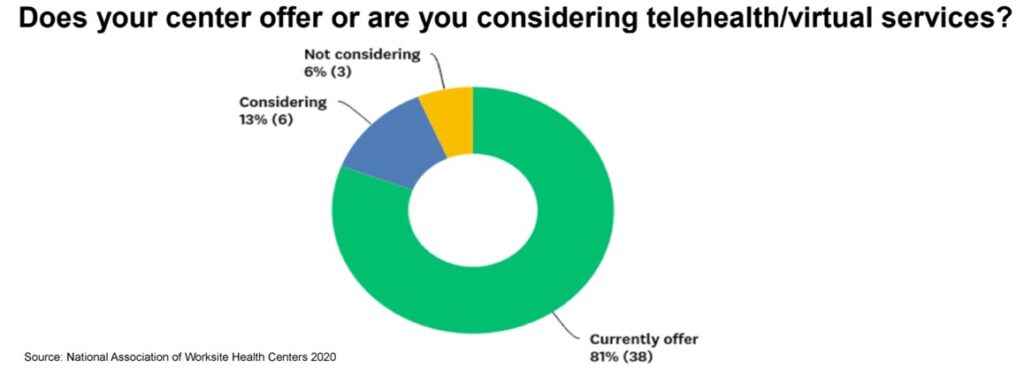Workplace health centers fill gaps for employees both during and post pandemic
Telehealth, mental health, and COVID-19 care are growth factors for on-site clinics.

Last year, while the pandemic shuttered offices nationwide, one workplace wellness site may have thrived: on-site health clinics.
Early in the pandemic, clinics struggled to adjust like everything else. But as the need for primary care, mental-health support, and testing became apparent, some organizations chose to increase their services.
A March 2020 survey conducted by the National Association of Worksite Health Centers and Mercer sought to establish how the pandemic impacted third-party clinic vendors and health providers. More than half the respondents’ indicated their served workforces were now remote, while a quarter remained primarily on-site. In addition, 57% of clinics planned to expand into telemedicine to serve employees even after the pandemic was over. “It was a major transition going from 80/20 in-person to 20/80 in-person,” says NAWHC executive director Larry Boress.

Before the pandemic, clinics typically conducted preventative screenings, handled prescription refills and offered physical therapy. During the pandemic, that shifted to COVID-19 screenings (85%), and testing (55%). Almost half the clinics surveyed offered mental health and behavioral health services.
The telehealth boom is proving the most significant change for on-site clinics. The survey found 74% of organizations said their clinic staffs were dedicated to telehealth. Ninety-one percent connect with patients through the telephone, and 74% added live video via phone, tablet, or computer. The services most offered via telehealth were chronic disease care (88%), primary care (79%), urgent care (82%) and COVID-19 screening (82%). “Before COVID, we’d seen the beginnings of virtual clinics, and all of that exploded,” says Boress.

A utility company expands clinic services
One example is LG&E KU Energy, a utility company that serves 90 counties in Kentucky and Virginia. In January of 2020, the company, which employs 3,500 workers, opened two on-site health centers that operated for a mere two months before it scrambled to adapt to the pandemic.
One of the two clinics operated as an occupational medicine facility for all employees. The other served as a primary-care center for employees enrolled in the health plan. When the pandemic hit, only a third of the workforce went remote. The rest were still on-site and needed everything from COVID testing to injury care.
Still, LG&E quickly transitioned to telehealth, with COVID-19 screening done via telephone. The organization also waived its insurance co-pay and expanded mental health programming to meet all employees’ needs. About 35% of employees used the clinics last year.
The utility increased its services by working with other providers and clinics for testing and getting antiviral medications to its high-risk employees. DeAnna Hall, LG&E’s corporate health and wellbeing manager, says she’s sure lives were saved by the ability to get quick results when so many other medical centers in its area were over-burdened.

“With the critical nature of our business, we needed to be able to get a PCR COVID test so we could do contact tracing to keep our workforce healthy, and we needed same-day results,” Hall says. “We used providers at the workplace clinic and our internal team to determine who needed the instant PCR and who just needed to be seen virtually for non-COVID reasons.”
LG&E plans to keep many of its subsequent changes, including a telehealth option, waived mental-health fees, and home delivery of prescription medications for employees. Hall says clinic usage is increasing now that remote workers are returning to the office. She says people will visit the clinic for annual physicals, then use telehealth for any follow-up. “Early in March, we went through our entire health and wellness program and asked ‘What can be virtual and what can’t be virtual? Whatever can be virtual, can we keep it virtual moving forward?’” Hall says. “That will be what we try to focus on.”
Mental health support is a significant trend for on-site health clinics. With the uptick in depression and anxiety, 47% of the clinic respondents said they saw more behavioral health and stress problems. Some clinics began adding referral services or virtual support options. “The recognition that mental-health issues were were a comorbidity of any chronic disease or injury somebody had meant you had to offer it,” Boress says. “That will grow because people continue to have issues.”
Clinics going forward
A year after the initial survey was taken, Boress says the numbers around in-person and virtual access have flipped. As many as 70% of clinics are seeing people in person rather than through telehealth. He says 30% will offer virtual care and most are expanding pre-pandemic services, likely through third-party contracts. Others will add staff. “I don’t think there’s any doubt it’s expanding, because of people’s comfort level and the employer wanting to provide services needed by the population,” Boress says. “I definitely believe it will be a core element of business going forward.”
Employers are also offering COVID vaccinations. “What we’re finding is most employers won’t mandate the vaccine, but they will be educating their teams about it, where to get it, debunking myths,” Boress says. “There will be employers incentivizing people.”
In December, the NAWHC had discussions with the CDC about the importance of using worksite health clinics as vaccination sites. But private employers were given no role to play, despite the clinics’ capabilities, and the fact that some were already vaccinating employees before COVID. More than 11 million employees could be vaccinated through on-site clinics if that option becomes available.
Employers recognize the need to provide care for not just their headquarters’ workers but at all job sites, says NAWHC’s Boress. Especially if an office is smaller, it’s not financially feasible to offer on-site care. Consequently, employers and vendors are looking at medical carts, kiosks, cabins, or mobile units to ensure all employees have the same benefits. “What we’re finding is none of the centers are going to close, but instead they’ll expand and continue to be a growing industry,” he says.
Amazon opens health centers during pandemic
One company that’s piloting on-site health services is Amazon, which launched Amazon Care as a pilot program for employees in the Seattle area in 2019. It began as a virtual primary-care clinic with an option for nurses to visit employees in the home. An app allowed employees to see a doctor, nurse practitioner or nurse via video. It also provided prescriptions for employees to fill at their preferred pharmacy.
Amazon decided to move ahead with on-site health centers, called Neighborhood Health Centers, last summer. Despite the pandemic, the clinics opened in five cities across the U.S., including in Texas, Arizona, Kentucky, Michigan and California. All the centers are located near operational sites, like fulfillment centers where employees have worked nonstop through the pandemic.
Managed by Crossover Health, the centers provide preventative, primary, and urgent care for employees and their families. Employees also receive mental-health support and wellness coaching. Eventually, Amazon plans to offer COVID-19 vaccinations on site. The company plans to open 17 clinics in these cities to serve 115,000 workers.
Amazon is continuing to use Amazon Care as its telehealth option for workers. It plans to expand the program to its employees nationwide. “Across the U.S., an increasing number of patients do not have easy access to a primary care physician and instead utilize emergency or urgent care options, which is not only more expensive for patients, but also overlooks important preventative care opportunities,” said vice president of human resources Darcie Henry on the company’s website. “We want to solve that for our employees, and the launch of these new Neighborhood Health Centers will provide a range of quality primary care services for employees across the country—further strengthening Amazon’s industry-leading benefits program, which provides comprehensive health care for employees starting on day one of employment.”
COMMENT
Ragan.com Daily Headlines
Tags: Amazon, on-site clinics, telehealth, Wellness, workplace health centers






